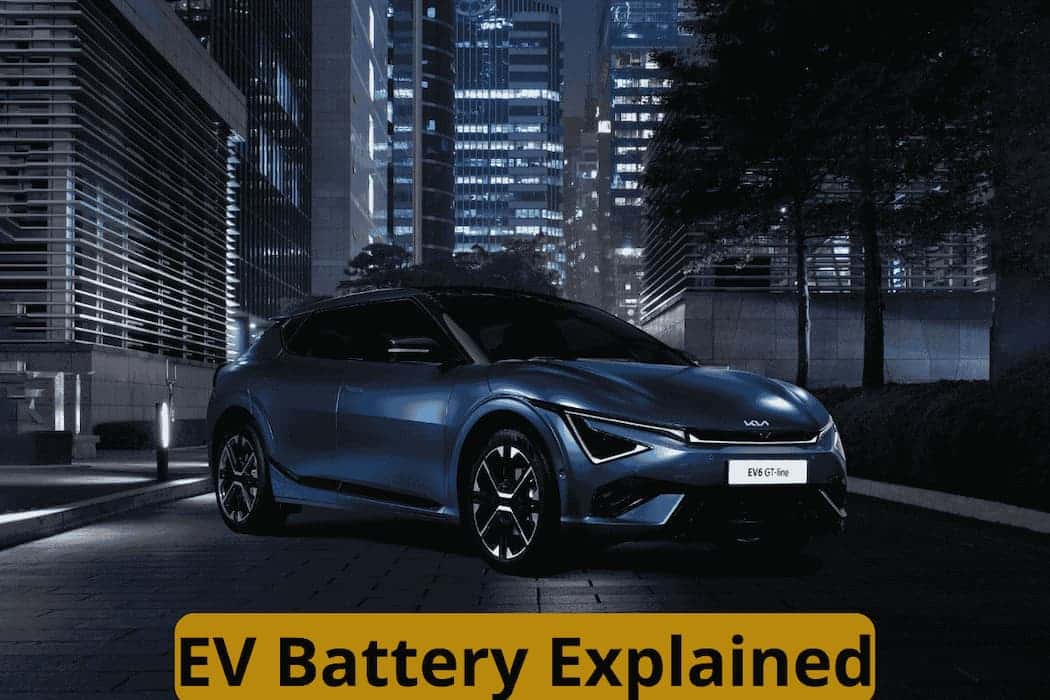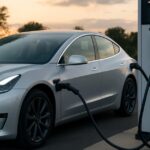EV batteries are like the “heart” of electric cars, giving them the power to go from one place to another without using gasoline!
What are EV Batteries?
The powerhouse for electric cars, buses, and trucks is the EV batteries. Unlike regular car models, which depend on diesel or gasoline, EVs utilize electricity stored in batteries. The electric motor transforms power into energy, which in turn helps move the wheels.
Most smartphone and laptop batteries are Lithium-ion batteries, and so are most EV batteries.
What are the components of an EV battery?
1. Anode – The Negative side of the battery. The Anode is one of the electrodes and is usually made of carbonaceous materials. It captures lithium ions during charging.
2. Cathode – The Positive side of the battery. It Captures lithium ions as “Li+” when the battery is used. Lithium compounds such as lithium iron phosphate or nickel cobalt manganese make most cathodes.
3. Electrolyte – The electrolyte of a lithium-ion battery is a special type of liquid that can operate effectively between the Anode and cathode.
4. Separator – The Separator is made of thin-film material that absorbs between the Anode and cathode, allowing it to touch and twist without short-circuiting. The separator is perforated, allowing lithium ions to move from one side to another.
5. Battery Management System (BMS) – Batteries with the integrated BMS can monitor state of health (SOH), state of charge (SOC), temperature, and battery conditions to manage energy outputs and protect all internal components.
6. Housing – The battery’s outer shell that covers the components and holds everything in place is called housing. It is created to provide battery safety from external factors and secure the parts during vehicle movement.
Types of EV Batteries
Electric vehicles (EVs) use different types of batteries, each with its own benefits and challenges.
1. Lithium-ion Batteries (Li-ion)
This is the most commonly used type of energy storage for EVs. Lithium-ion batteries are widely used in EVs because of their high energy density. They pack a lot of power for their fixture size and are amongst the lightest batteries available. These batteries boast high cycle and calendar life and great energy efficiency during charging and discharging. Most modern electric vehicles from Tesla and numerous other manufacturers utilize this technology.
2. Nickel-Metal Hydride Batteries (NiMH)
NiMH batteries are used in older hybrid vehicles and some hybrid models today. They do not have as much energy efficiency as lithium batteries, but they are much safer in certain conditions and have a longer lifespan. They are also more durable and often cheaper to replace in extreme temperatures.
3. Solid-State Batteries
This new and exciting technology is used, especially in R&D situations. Solid batteries are used in electronics, which you can say is an improvement over lithium batteries. The added benefit of solid-state batteries is the solid electrolytes they contain. This is an improvement because it produces less risk than liquids with prominent fire and leaking. Solid-state batteries reduce the risk of explosion and provide better range. Unfortunately, these alloys have not yet been put to use in EVs.
3. Lead-Acid Batteries
Older models typically use Lead-acid batteries, and Electric Golf Carts rely on them. They are extremely cheap and reliable, but with a hefty downside. And by downside, I mean lower than two hundred times on a scale of 1–10 compared to Lithium batteries because they cannot provide as much energy as people require.
How Do EV Batteries Work?
1. Charging Up
To begin with, the battery must be charged. You can do so at home, work, or at public charging stations for EVs. When your EV is plugged in, electricity moves from the power grid into the battery and is stored there until you intend to use the vehicle.
2. Powering the Car
When you switch on the EV, the electric battery transforms the stored electricity into the energy needed to start your electric motor. Unlike gasoline engines, electric motors are quiet and start immediately.
3. Driving
The electric battery rotates, powering the motor that makes the wheels turn. The best part about EVs is their ability to accelerate at high speeds, as the electric motors provide maximum rotational force immediately.
4. Regenerative Braking
A unique feature of EVs is regenerative braking. It can increase the car’s efficiency by saving energy. Pressing the brake pedal stops the car, but instead of using brake pads, the EV slows the vehicle with the motor. This aids in recharging the battery while driving since it uses some energy and restores some.
Advantages of EV Batteries
Electric vehicle (EV) batteries offer many advantages, especially as more people switch to eco-friendly transportation.
1. Environmentally Friendly
EV batteries reduce pollution emissions. Vehicles powered with engines that depend on gasoline typically emit CO2 due to burning fossil fuels. On the other hand, EVs use electricity, which results in almost zero emissions. Such action greatly helps reduce global warming.
2. Energy Efficiency
Energy consumption in EVs is lower than that of gas-powered vehicles with motors. This translates to higher efficiency in electric cars. Hence, electric vehicles are cheaper even with the higher upfront purchase cost.
3. Lower Operating Costs
Electric car users incur fewer costs when charging for an electric car than gasoline-powered cars. The lower complexity of EVs reduces repair and maintenance costs. There are no oil changes, and the brakes last longer on EVs as they operate on regenerative braking.
4. Quiet and Smooth Ride
Driving an EV means quieter surroundings. Those who share the environment with the car benefit from a less noisy environment and a much smoother and quieter vehicle than an ordinary gasoline-powered vehicle.
5. Incentives and Rebates
Many governments use tax rebates or grants for EV purchases. These incentives reduce the overall expense of EVs, making it easier for consumers to buy them.
6. Renewable Energy Compatibility
EVs can charge using solar or wind power, lowering their carbon footprint and helping achieve sustainable energy goals.
Disadvantages Of EV Batteries
Electric vehicles (EVs) are often seen as a key component of a cleaner future. However, their batteries, which are critical for running them, have several drawbacks.
It’s important for buyers and those making car rules to know about these issues.
1. High Initial Cost
Electric cars are usually more expensive than traditional vehicles due to the EV batteries. A sophisticated level of technology and expensive materials are required to build these, making them hopelessly expensive for the majority.
2. Limited Range and Availability of Charging Stations
EV and potential EV owners worry about how far electric vehicles can be driven on a single charge. The range of EVs is getting increasingly better but does not come close to focusing on gas-powered cars and charging locations are still emerging for long-distance travel.
3. Long Charging Time
Filling an electric car’s battery will always be more time-consuming than refuelling a gas car. One can’t expect to get power from a home charger quickly; it takes several hours. Even the more advanced on-the-go chargers will still take 20-30 minutes. AEV owners who are not accustomed to waiting for power get frustrated.
4. Limited Charging Infrastructure
Support infrastructure for electric vehicles is growing for the most part, but some regions are still below average.
Gas stations are readily available worldwide, but not all areas have public electricity charging stations, making travelling with an EV a bit cumbersome. EV travellers may find it hard to locate the charging station in a region they are not familiar with. Moreover, even in places where charging stations are available, chargers might not be powerful enough, which adds more cons for long trips.
5. Environmental and Ethical Concerns
The production of EV batteries is detrimental to the environment. Extracting lithium and cobalt is particularly energy-intensive and can harm the natural surroundings. It is also unhealthy for the people who have to do the work. Moreover, batteries are still challenging to recycle and are not always recycled properly.
6. Battery Degradation and Replacement Costs
The longevity of EV batteries is in question. Battery life shrinks with time and usage and is further complicated by adverse weather conditions and extreme temperature fluctuations. Once the battery reaches its limit, it is very costly to replace.
7. Recycling Challenges
Yet another drawback is the inability to recycle EV batteries effectively. Even as improvements are attempted, the combination of materials that make up these batteries makes appropriate recycling elusive. Only a small percentage of EV batteries are recycled; most are disposed of in landfills. This is a problem because it harms the environment and decreases the ability to use EV batteries sustainably in the future.
8. Limited Availability of Raw Materials
The raw materials required for manufacturing electric car batteries are scarce. With the growing need for electric vehicles, materials such as lithium, cobalt, and nickel are also increasing. The availability of these materials is limited because they are not abundant. This can cause disturbances in the supply chain and result in price fluctuations, thus making it harder for manufacturers to produce EV batteries at scale.
Additionally, mining for these materials raises ethical and environmental issues that could hinder efforts to achieve a sustainable future.
9. Weight and Design Limitations
The weight of electric vehicle batteries is an issue, as they are cumbersome. This causes the cars to have extra weight, which alters their mobility and energy consumption. The cars require more energy than necessary to move, thus wasting power.
10. Lack of Standardization
Manufacturers lack a universal regulation or standard for electric vehicle batteries, which creates concern. Manufacturers face issues with different battery types and sizes for their vehicles. This poor balance can lead to problems for users, such as purchasing new batteries or chargers that are not equipped with the correct specifications.
Furthermore, the absence of universal regulation makes improving infrastructure, such as establishing a charging station network, difficult.
Read more: How Long Do EV Batteries Last?







